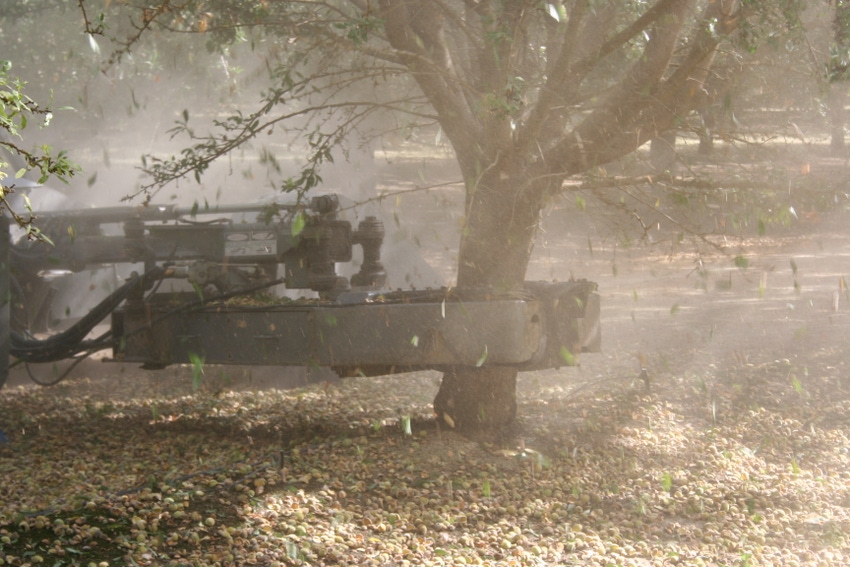November 17, 2016

Like death and taxes, one thing is certain with almond harvest. It kicks up a lot of dust.
Growers and equipment manufacturers are making inroads as they seek to reduce the amount of dust they generate. But it’s not easy, nor is it cheap.
“Controlling dust – not simply reducing it – can be a challenge,” said Stuart Layman, a Flory sales representative. “Playing in the dirt makes it more challenging.”
And the price tag is not low. Flory’s current harvester sells for $189,000. But, Layman says it can reduce dust up to 60 percent. Its features include the ability to lower fan speeds and reduce other dust-causing processes from the cab of the machine as it moves through the orchard.
Layman said the diameter of the fan on the machine was increased and the RPM’s slowed by 30 percent. It also has a longer pre-cleaning chain, and the belt is made of chain instead of solid rubber.
Jim Percy, 74, who has been farming almonds in Fresno for 25 years, is among those willing to pay an added price to keep dust down. He paid about $60,000 for a harvester from Exact Corp. of Modesto. He said features on the machine which target dust reduction cost an added $10,000.
The machine has a patented wafer brush system that drops dust to the ground. Percy said it also has nozzles that spray the dust.
Percy is in his fourth year of using the low-dust equipment in his 140 acres of almonds.
“When you can eliminate 40 to 70 percent of the dust, it’s less in the atmosphere,” he said. “I know if I can do my part in making less dust (then) that��’s what I want to do.”
In addition to being a good neighbor, something urged by the Almond Board of California in workshops around the state, Percy sees an added advantage in not stirring up dust that could drift into his vineyard and provide a haven for mites.
“Miticides are expensive,” he said.
Some growers may hang on to their equipment – whether efficient or not – for a long time. Others do not. Percy replaces his harvester every 8 to 10 years. His son-in-law, who does custom harvesting, buys one every two years.
Exact works closely with farmers to develop innovative strategies. In 2004, the company reduced dust by introducing the industry’s first “berm brush” on sweepers, which follows the contours of varied orchard layouts.
In 2009, the company produced it first low-dust harvester with the EcoClean system.
“The patented Eco-Clean system uses a little moisture and wafer brushes to scrub dust out of the air,” said Doug Flora, vice president of Exact Corp. “Farmers can go in and pick up the crop, and neighbors don’t even know they’re there.”
The Almond Board’s attention to the issue has grown, along with the industry’s footprint and the presence of orchards near highways and neighborhoods.
The Board points out that almond harvest is a three-step process involving a machine that shakes the nuts from the tree to the ground, where they dry for several days; plus sweeping the almonds into rows with a sweeper machine; and then picking them up off the ground for transport to a local processing facility.
Growers have long had a voice in the building and tweaking of harvesters, said Jarred Hettinger, a territory manager for Jackrabbit.
“They are constantly coming up with innovative ideas to help reduce dust without reducing the efficiency of the harvest,” he said.
He cited an example of their suggestions for tweaking a machine that puts nuts in a windrow. They originally came up with the idea of adding brushes. Then they suggested extending “crowders” to push nuts into rows. They also suggested adding a fan that blows leaves away.
Hettinger said the added fan has proven particularly helpful in harvesting of walnuts.
“If leaves mat together product is lost,” he said.
Hettinger added that the evolution of equipment is far from over.
“We will continue to develop new and innovative equipment as the market evolves,” he said.
Part of the Almond Board’s push – along with efforts by growers and harvesters – is an emphasis on training.
“At my family’s operation, employees are trained on how to set the sweeper to move as little dust as possible,” said Randy Bloemhof, a partner at Bloemhof Custom Harvesting in Kern County.
“With our sweepers, we are doing fewer passes, thus reducing the percentage of dust created during the process but also doing the same job with a third less of the work.”
In addition to discussing the latest harvesting equipment, harvesters and manufacturers also talk about best equipment and orchard practices, regardless of equipment age.
“We promote the proper adjustment of all harvesting equipment to lessen the pickup of external debris to help eliminate dust emissions,” said Larry Demmer, general manager of Weiss McNair.
“In terms of manufacturing low-dust equipment, Weiss McNair’s Posifloat suspension system, which is built into the sweeper machine, allows the sweeper head and brush assembly to better follow the contour of the orchard floor, ensuring minimum disruption to surface soils.
The Almond Board has developed a series of harvest dust resources to provide guidance on how to best adapt harvest practices and equipment to local orchard conditions. The resources include a ‘Managing Dust at Harvest’ technical guide, tool kit, and educational videos in English and Spanish.
The Board, manufacturers, the Almond Alliance of California, and others have also worked to make funds available from the Natural Resources Conservation Service through its Environmental Quality Incentive Program for almond growers who use harvest equipment proven to significantly reduce dust.
You May Also Like




